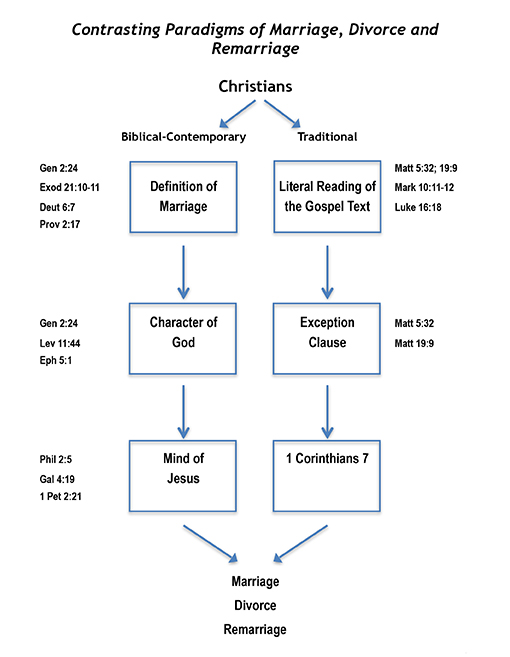 The next issue that demanded examination was the ‘exception clause’ found in Matt 5:32 and 19:9. Two major concerns became apparent: 1) How should the word porneia be understood, and 2) What was the origin of the clause? Evidently Matthew did not think porenia and the word for adultery (moikia) had the same meaning because he used both terms in Matt 15:19. This distinction is also supported by other texts such as Mark 7:21, Cor 6:9, and Heb 13:4. After extensive research, I determined the two most probable meanings for porneia were incest or unfaithfulness during the engagement. The later supported Joseph’s plan to divorce Mary and the former addressed the issues of Gentiles integrating into Matthew’s Jewish church. Significantly, Mark, Luke and Paul showed no knowledge of the exception clause therefore their Greco-Roman readers would have been oblivious to it. If that were the case, what was its origin? Two options seemed most probable: (1) Jesus could have included the clause but if the teaching were truly significant, why did the other synoptic authors omit it? (2) Matthew inserted the clause to deal with the issues his Jewish audience was facing. Also, If the exception was added by Matthew, the synoptic gospels (and Paul) supported Jesus’s explanation of Gen 2:24 (“what God joined together, let man not separate”), and explained the disciples’ response in referring to marriage in Matthew 19.
The next issue that demanded examination was the ‘exception clause’ found in Matt 5:32 and 19:9. Two major concerns became apparent: 1) How should the word porneia be understood, and 2) What was the origin of the clause? Evidently Matthew did not think porenia and the word for adultery (moikia) had the same meaning because he used both terms in Matt 15:19. This distinction is also supported by other texts such as Mark 7:21, Cor 6:9, and Heb 13:4. After extensive research, I determined the two most probable meanings for porneia were incest or unfaithfulness during the engagement. The later supported Joseph’s plan to divorce Mary and the former addressed the issues of Gentiles integrating into Matthew’s Jewish church. Significantly, Mark, Luke and Paul showed no knowledge of the exception clause therefore their Greco-Roman readers would have been oblivious to it. If that were the case, what was its origin? Two options seemed most probable: (1) Jesus could have included the clause but if the teaching were truly significant, why did the other synoptic authors omit it? (2) Matthew inserted the clause to deal with the issues his Jewish audience was facing. Also, If the exception was added by Matthew, the synoptic gospels (and Paul) supported Jesus’s explanation of Gen 2:24 (“what God joined together, let man not separate”), and explained the disciples’ response in referring to marriage in Matthew 19.
The New Testament is strangely silent on issues dealing with marriage and divorce, and after years of study, I was faced with the dilemma of maintaining the integrity of the text and integrating its principles into a 21st century world. The textual silence is especially problematic given the common practice of divorce in the Greco-Roman world and the popularity of the no fault divorce in the Jewish culture. Seemingly if marriage and divorce had been an issue in the early church, it would have been the topic of more instruction. A theology on the topic could not be based in part upon metaphors and hyperboles used to communicate its message.
I was convinced that because of occasion, linguistic style, and historical context, the marriage and divorce texts had built in limitations.
As I reflected on the biblical story as a whole I realized perhaps I had missed the obvious. Paul was the apostle to the Greco-Roman world of the first century (Acts 9:15; Gal 2:7). It was a world of paganism characterize by immoral conduct (Rom 1:26-32; 1 Cor 5:1; 7:2). As I studied the writings of Paul, I concluded Paul’s foundational approach for the ethical and doctrinal challenges he faced in the Greco-Roman world were two fold: the character of God and the mind of Jesus. Whether Paul was dealing with conduct or doctrine, his approach was always the same. Because of his strong rabbinic background and his understanding of the teachings and life of Jesus, this was the natural foundation for his ministry. The more I reflected the clearer a biblical/contemporary pattern of marriage and divorce became.
Because of his understanding of Torah, Paul believed God should be imitated and followed (Eph 5:1; Col 3:10; 1 Peter 1:15-16). God’s marriage to Israel became the standard. God’s patience, compassion, forgiveness and his determination to save marriage became Paul’s paradigm.
The mind and ministry of Jesus became the lens through which he determined the proper conduct for all disciples (Gal 4:19; Col 1:27; 2:6; Rom 8:29; 13:14; 2 Cor 3:18).
 Using the character of God and the mind of Jesus as the benchmark, Paul declared what conduct was right or wrong. In an ideal world, divorce would be a non-issue but the world is anything but ideal. We are a flawed people living in a flawed world. People divorce. Perhaps instead of imposing our opinions on how various situations should be viewed, we should take a cue from Paul. When we approach all of life through the lens of the character of God and the mind of Christ, our sight is clarified. Such was the goal in writing my book, Marriage, Divorce, and Remarriage: Seen Through the Character of God and the Mind of Jesus. Even with a lack of information on how the early church dealt with specific situations, we can navigate life’s most complex issues, including those surrounding marriage and divorce.
Using the character of God and the mind of Jesus as the benchmark, Paul declared what conduct was right or wrong. In an ideal world, divorce would be a non-issue but the world is anything but ideal. We are a flawed people living in a flawed world. People divorce. Perhaps instead of imposing our opinions on how various situations should be viewed, we should take a cue from Paul. When we approach all of life through the lens of the character of God and the mind of Christ, our sight is clarified. Such was the goal in writing my book, Marriage, Divorce, and Remarriage: Seen Through the Character of God and the Mind of Jesus. Even with a lack of information on how the early church dealt with specific situations, we can navigate life’s most complex issues, including those surrounding marriage and divorce.
I readily admit my journey is far from over and my treatise is certainly not the final word on the topic. I invite you to join me in the pursuit of the heart of God and the mind of Christ as we study the truths in His word.
To read the previous articles in this series, please follow these links:
Kathy Hodge Denham says
This is remarkable!! Thank you Jerry Jones
Mike Bucchi says
Jerry – thanks for your in depth study of these topics. I admire your ability to do the research of the texts and put them in context. I confess, I struggle getting myself comfortable with my own beliefs and interpretations on the subject of marriage, divorce and re-marriage. As you have so well brought to light, it’s not as plan and simple as we thought in our younger years. I think I need to do another “slow” read of your book, these segments and try to visually graph the scriptures out.
I very much appreciate your attempt to put all of the related scriptures in historical perspective. .. Old Testament (Torah); the Jewish mindset and the Greco-Roman thought process.
Definitely, not a simple problem or answer! Thanks again for your deep dedication to this subject and all of God’s word!! Mike Bucchi
Mike Bucchi says
Confirming submission.
Mike says
Hay, I think you might enjoy reading my small book on divorce and remarriage. It’s endorsed by many professors. The Cure for Divorce: In the Kingdom of God. It has a unique outlook. Michael Sayen
Jerry Jones says
Thanks, Mike, we will order it. Have you ready my book “Marriage, Divorce, and Remarriage: Seen Through the Character of God and the Mind of Jesus”?
Jerry
Michael Sayen says
No.